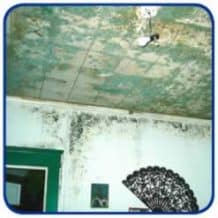History of Mold and Man

Since Biblical times it has been known that indoor mold growth can be a health hazard:
Leviticus 14:39-47. “On the seventh day the priest shall return to inspect the house. If the mildew has spread on the walls, he is to order that the contaminated stones be torn out and thrown into an unclean place outside the town. If the mildew reappears in the house after the stones have been torn out and the house is scraped and plastered, it is a destructive mildew and the house is unclean. It must be torn down – its stones, timbers and all the plaster – and taken out of town.”
Image: Rooms that are not well ventilated, or rooms exposed to the weather in humid climates, can be overrun by mold in a short time.
Several times throughout history mold has been identified as the cause behind the mysterious deaths of farm animals.
Stachybotrys chartarum was found growing on wet grain used for animal feed, and the resulting toxins poisoned the animals. Today, the agriculture industry keeps a close eye on mold and mycotoxin levels in grains to prevent the contamination of animal feed and human food supplies.
Stachybotrys chartarum is a fungus that has become notorious as a mycotoxin producer that can cause animal and human mycotoxicosis. Over the past 15 years in North America, evidence has accumulated implicating this fungus as a serious problem in homes and buildings and one of the causes of the “sick building syndrome.” In 1993-1994, there was an unusual outbreak of pulmonary hemorrhage in infants in Cleveland, Ohio, where researchers found S. chartarum growing in the homes of the sick infants. This incident increased the awareness of home/building molds and brought this fungus to the immediate attention of the medical community. In recent years there has been a cascade of reports about toxic molds in the national media.
The New York Times Magazine, August 12, 2001, ran a front page story on toxic mold. Newspaper articles (Fig. 1) such as “Fungus in ‘Sick’ Building” (New York Times, May 5, 1996) or “Mold in schools forces removal of Forks kids” (Fargo Forum, June 1997) are eye-catching news items. The nationally syndicated comic strip Rex Morgan ran a series on Stachybotrys, and television news shows have run entire programs on Stachybotrys contamination of homes. The fungus has resulted in multimillion dollar litigations and caused serious problems for homeowners and building managers who must deal with the human issues and remediation.
In the 1970s, building construction techniques changed in response energy crises, and homes and commercial buildings became more air-tight. At the same time, cheaper materials such as drywall moved into common use. This combination of increased moisture because of higher humidity and suitable surfaces for mold growth led to an increase in mold indoors.
The recent increase in serious storms and flooding has increased the danger greatly, and some health experts have even predicted a large number of deaths among those of the threatened population with suppressed immune systems.
Molds and fungi growing inside buildings may be the source of indoor air-quality problems known as the “sick building syndrome.” While the syndrome has been blamed on a variety of causes, from the emissions of particleboard partitions and paints to carpets and cleaning supplies, Georgia Tech research has found that metabolic gases emitted from molds and fungi may be a significant source of airborne volatile organic compounds (VOCs) that can cause indoor air-quality problems. The new research suggests that control measures prescribed for sick buildings may need to be altered to address microbial problems as well as building materials.
Next : Types of Mold and the Harm They Cause






